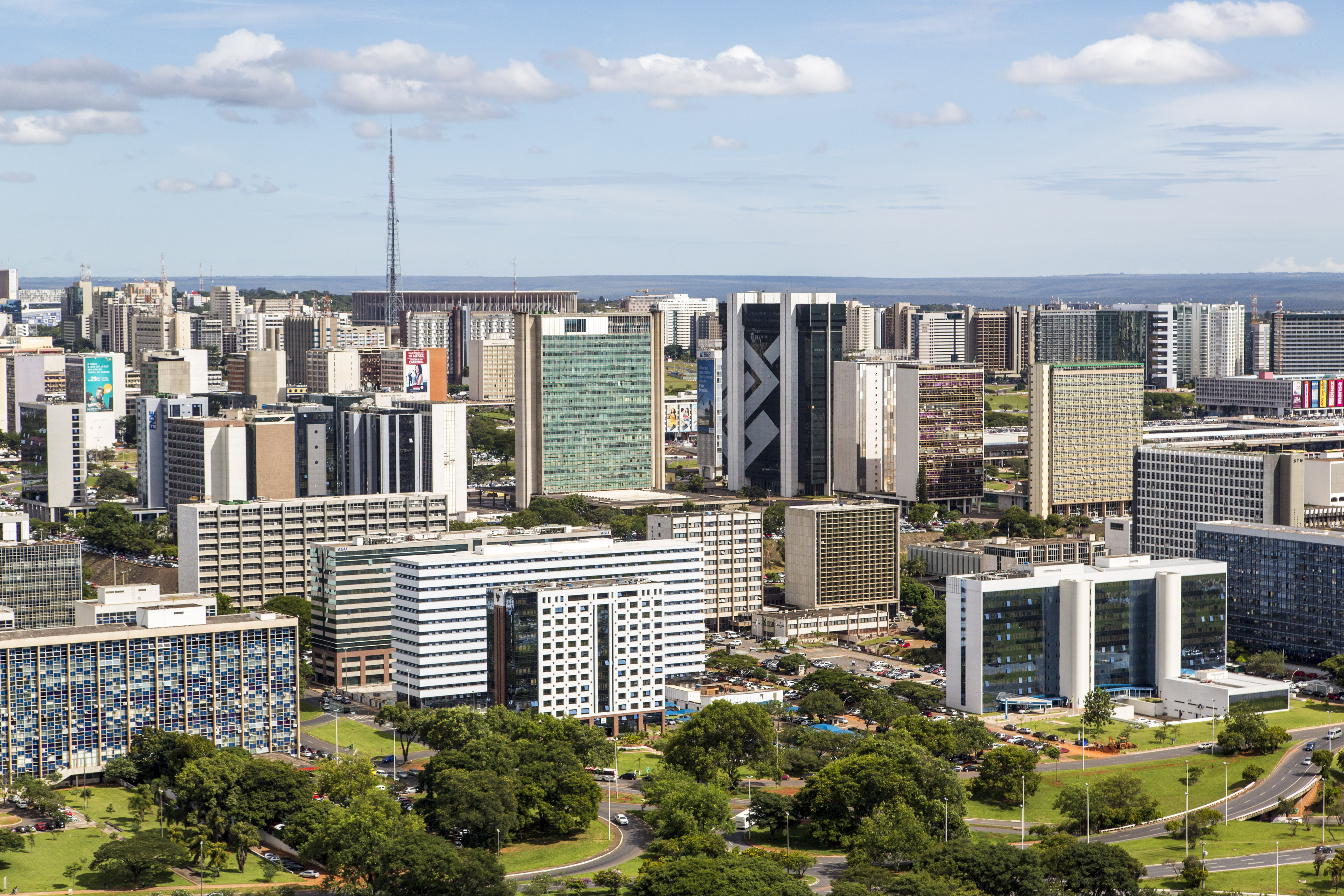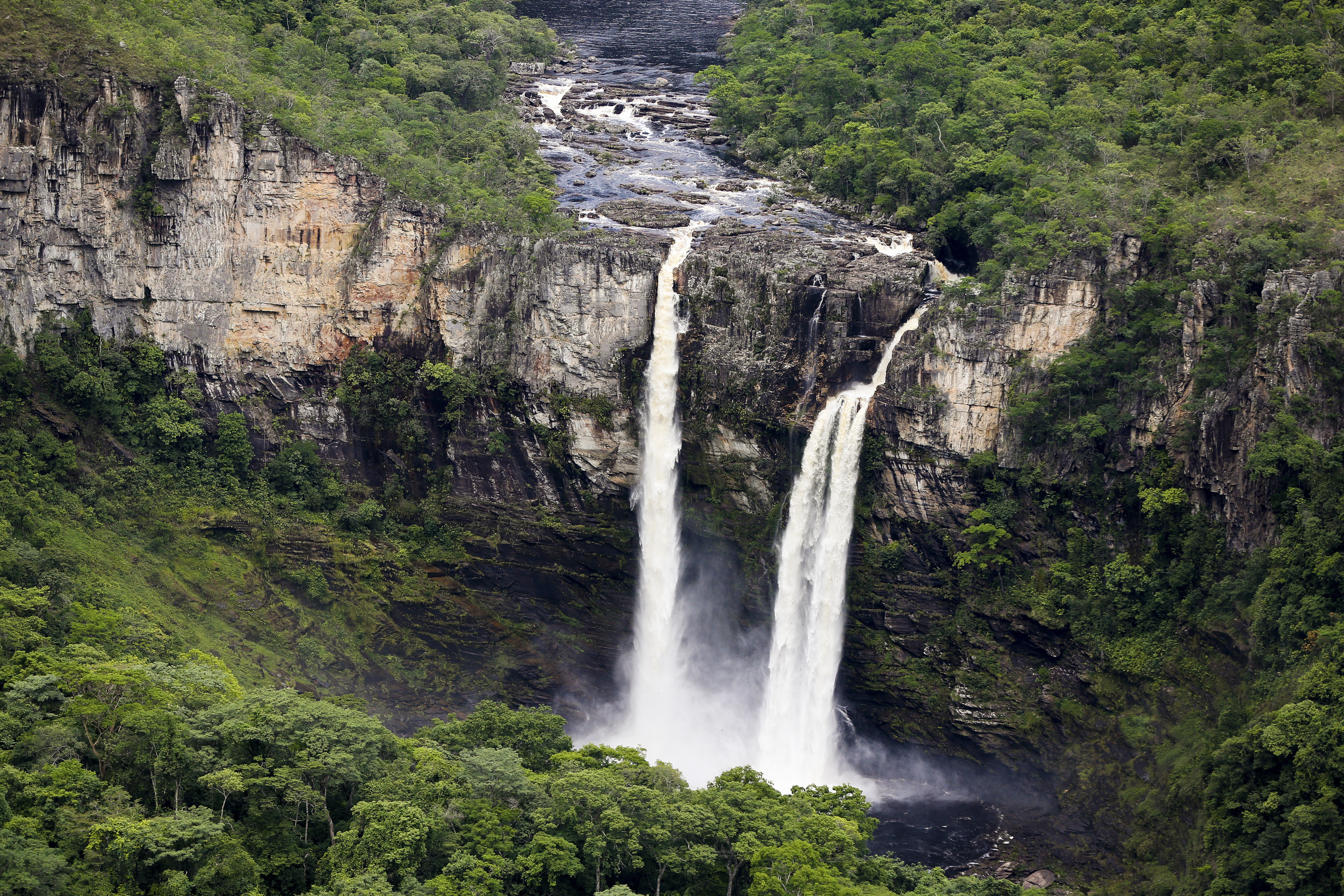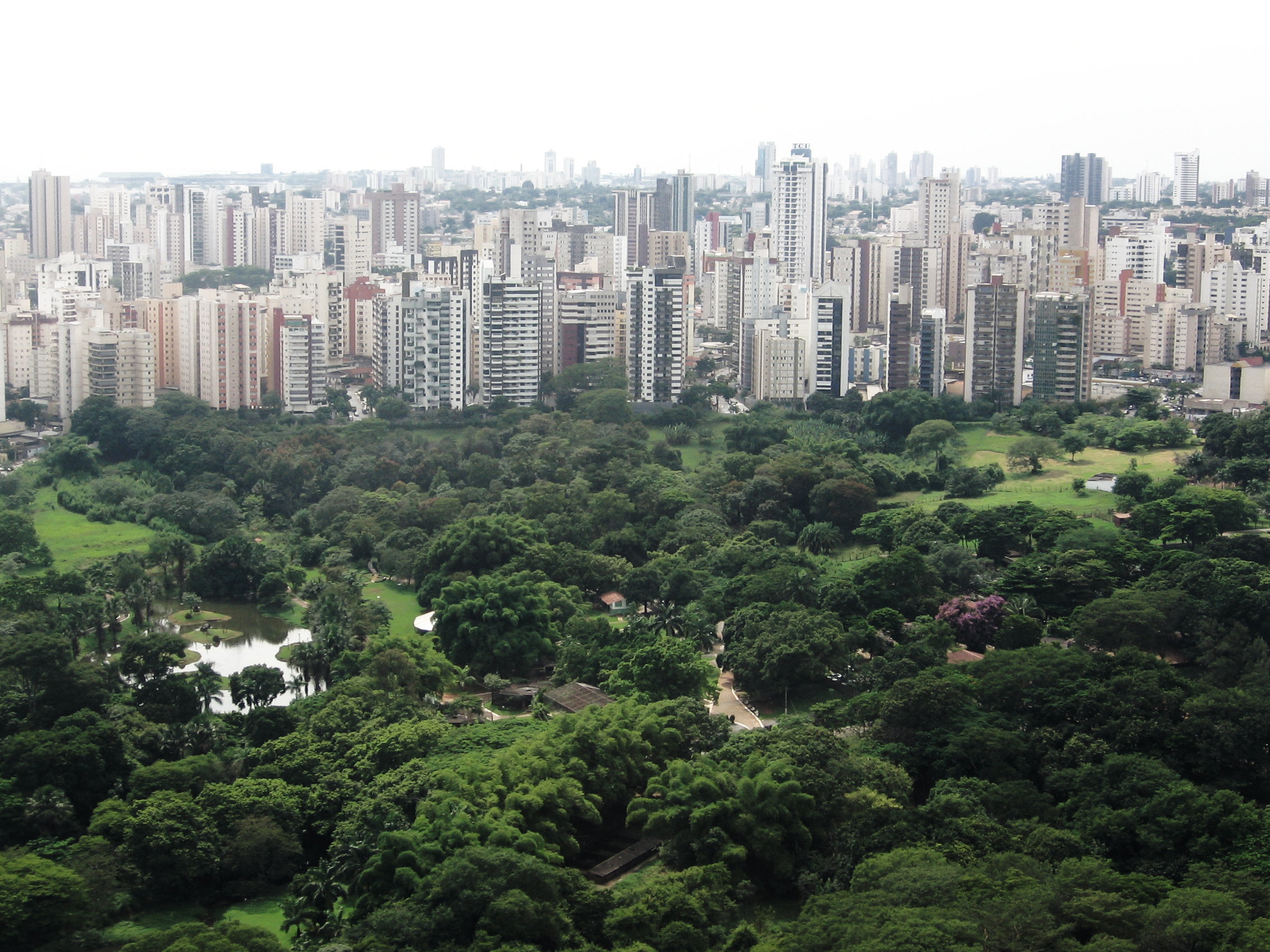|
Planaltina, Goiás
Planaltina is a city located in the Metropolitan Region of Brasilia, center of the state of Goiás, Brazil. While the official city name is Planaltina, it is also informally referred to as Planaltina de Goiás or Brasilinha (Little Brasília). Location and Geography Planaltina is part of micro-region 12 of the state, the so-called Entorno do Distrito Federal. It borders Água Fria de Goiás, Formosa, Mimoso de Goiás, Padre Bernardo and, the Distrito Federal. It is located on the northeastern boundary of the Federal District north of the satellite city of Planaltina, DF. It is 273 kilometers from the state capital Goiânia and . from Central Zone ( Plano Piloto). Planaltina is the gateway to an enormous area of ecological preservation, in which can be found the important Chapada dos Veadeiros national park. Nearby is Lagoa Formosa, which, with its 17 square kilometers of surface area, is the largest natural lake in the state of Goiás. Also nearby is the source of the Mar ... [...More Info...] [...Related Items...] OR: [Wikipedia] [Google] [Baidu] |
Municipalities Of Brazil
The municipalities of Brazil () are administrative divisions of the states of Brazil, Brazilian states. Brazil currently has 5,571 municipalities, which, given the 2019 population estimate of 210,147,125, makes an average municipality population of 37,728 inhabitants. The average state in Brazil has 214 municipalities. Roraima is the least subdivided state, with 15 municipalities, while Minas Gerais is the most, with 853. Northern states are divided into small numbers of large municipalities (e.g. Amazonas (Brazilian state), Amazonas is divided into only 62 municipalities), and therefore they cover large areas incorporating several separated towns or villages that do not necessarily conform to one single conurbation. Southern and eastern states on the other hand, are divided into many small municipalities (e.g. Minas Gerais), and therefore large urban areas usually extend over several municipalities which form one single conurbation. The Federal District (Brazil), Federal Distr ... [...More Info...] [...Related Items...] OR: [Wikipedia] [Google] [Baidu] |
Esplanada Dos Ministérios (15232674849)
Esplanada is a municipality in the state of Bahia in the North-East region of Brazil. See also *List of municipalities in Bahia This is a list of the municipalities in the state of Bahia (BA), located in the Northeast Region of Brazil. Bahia is divided into 417 municipalities, which were, until 2017, grouped into 32 microregions, which were grouped into 7 mesoregions. ... References Populated coastal places in Bahia Municipalities in Bahia {{Bahia-geo-stub ... [...More Info...] [...Related Items...] OR: [Wikipedia] [Google] [Baidu] |
Cerrado
The Cerrado () is a vast ecoregion of Tropics, tropical savanna in central Brazil, being present in the states of Goiás, Mato Grosso do Sul, Mato Grosso, Tocantins, Maranhão, Piauí, Bahia, Minas Gerais, São Paulo (state), São Paulo, Paraná (state), Paraná and the Federal District (Brazil), Federal District. The core areas of the Cerrado biome are the Brazilian highlands – the ''Planalto''. The main habitat types of the Cerrado consist of forest savanna, wooded savanna, park savanna and grass, gramineous-woody savanna. The Cerrado also includes savanna wetlands and gallery forests. The second largest of Biomes in Brazil, Brazil's major habitat types, after the Amazon rainforest, Amazonian rainforest, the Cerrado accounts for a full 21 percent of the country's land area (extending marginally into Paraguay and Bolivia). About 75% of the Cerrado’s 2 million km2 is privately owned. Vast amounts of research have shown that the Cerrado is one of the richest of all tropi ... [...More Info...] [...Related Items...] OR: [Wikipedia] [Google] [Baidu] |
Tocantins River
The Tocantins River ( , Parkatêjê dialect, Parkatêjê: ''Pyti'' [pɨˈti]) is a river in Brazil, the central fluvial artery of the country. In the Tupi language, its name means "toucan's beak" (''Tukã'' for "toucan" and ''Ti'' for "beak"). It runs from south to north for about . While sometimes included in definitions of the Amazon basin, the Tocantins is not a branch of the Amazon River, since its waters flow into the Atlantic Ocean via an eastern channel of the Amazon Delta, alongside those of the Amazon proper. It flows through four Brazilian states (Goiás, Tocantins, Maranhão, and Pará) and gives its name to one of Brazil's newest states, formed in 1988 from what was until then the northern portion of Goiás. The Tocantins is one of the largest Clearwater river (river type), clearwater rivers in South America. Course It rises in the mountainous district known as the Pirineus State Park, Pireneus, west of the Federal District, but its western tributary, the Araguaia Ri ... [...More Info...] [...Related Items...] OR: [Wikipedia] [Google] [Baidu] |
Maranhão River
The Maranhão River is a river of Goiás state in central Brazil. See also *List of rivers of Goiás References Brazilian Ministry of Transport Rivers of the Federal District (Brazil) Rivers of Goiás Rivers of Tocantins {{Goiás-river-stub ... [...More Info...] [...Related Items...] OR: [Wikipedia] [Google] [Baidu] |
Brasília
Brasília ( ; ) is the capital city, capital of Brazil and Federal District (Brazil), Federal District. Located in the Brazilian highlands in the country's Central-West Region, Brazil, Central-West region, it was founded by President Juscelino Kubitschek on 21 April 1960, to replace Rio de Janeiro as the national capital. Brasília is Brazil's List of cities in Brazil by population, third-most populous city after São Paulo and Rio de Janeiro, with a population of 2.8 million. Among major Latin American cities, it has the highest GDP per capita. Brasília is a Planned community, planned city developed by Lúcio Costa, Oscar Niemeyer and Joaquim Cardozo in 1956 in a scheme to move the capital from Rio de Janeiro to a more central location. The landscape architect was Roberto Burle Marx. The city's design divides it into numbered blocks as well as sectors for specified activities, such as the Hotel Sector, the Banking Sector, and the Embassy Sector. Brasília was inscribed as a UN ... [...More Info...] [...Related Items...] OR: [Wikipedia] [Google] [Baidu] |
Goiânia
Goiânia ( ; ) is the capital and largest city of the Brazilian federative units of Brazil, state of Goiás. With a population of 1,536,097, it is the second-largest city in the Central-West Region, Brazil, Central-West Region and the 10th-largest in the country. Its Greater Goiânia, metropolitan area has a population of 2,890,418, making it the 12th-largest in Brazil. With an area of approximately , it has a continuous geography with few hills and lowlands, with flat lands in most of its territory, especially the Meia Ponte River, in addition to Botafogo and Capim Puba streams. Goiânia has its origins as a planned community, planned city, founded on October 24, 1933, by then Governor Pedro Ludovico to serve as the new state capital and administrative center. Before this, the state capital was the town of Goiás, Goiás, Goiás. It is the second most populous city in the Central-West Region, only surpassed by the country's capital Brasília, located about from Goiânia. The ci ... [...More Info...] [...Related Items...] OR: [Wikipedia] [Google] [Baidu] |
Planaltina, Federal District
Planaltina () is an Administrative region (Brazil), administrative region in the Federal District (Brazil), Federal District in Brazil. It is located in the east of the Federal District, bordering Fercal, Sobradinho, and Itapoã to the west, and Paranoá to the south. With an area of 1.534 square kilometers, it is the largest administrative region of the Federal District. Planaltina has a population of 177.540. The region seat was founded in 1859 and is the oldest city in the Federal District. History Beginning in the first half of the 18th century, bandeirantes came to this region looking for gold and emeralds. Existing documents do not tell us the exact date of the foundation of Planaltina, but it is believed to be 1790. According to oral tradition, the first name of the settlement was Mestre d'Armas because a blacksmith, expert in the art of fixing and dealing with weapons (armas), settled in the region. The founding of the nucleus, which gave birth to Planaltina is attribut ... [...More Info...] [...Related Items...] OR: [Wikipedia] [Google] [Baidu] |
Padre Bernardo
Padre Bernardo is a municipality located in the state of Goiás, Brazil. Location Padre Bernardo is located 42 km north of the boundary with the Federal District. It has boundaries with the following municipalities: *North: Mimoso de Goiás *South: Cocalzinho de Goiás *East: Planaltina de Goiás *West: Vila Propício The Economy The main economic activities are cattle raising and growing of corn and soybeans. Local commerce, with restaurants, bars, clothing and shoe shops, banks, supermarkets, among others, supply the basic necessities of the population. There are small industries of brick making, milk produces and clothing manufacturing. The largest employer in the town was the government. There were 02 bank branches in August 2007. In 2006 there were 137,000 head of cattle. The main agricultural products were rice, bananas, sugarcane, beans, coconuts, oranges, lemons, manioc, corn, and soybeans (11,000 hectares in 2006).Seplan Agricultural data 2006 *Farms ... [...More Info...] [...Related Items...] OR: [Wikipedia] [Google] [Baidu] |
Mimoso De Goiás
Mimoso de Goiás is a municipality in northeastern Goiás state, Brazil. Mimoso is located in statistical microregion 012, called Entorno do Distrito Federal. It is almost directly north of Federal District and is on an unpaved highway linking Padre Bernardo to Água Fria de Goiás. Municipal boundaries are with: *north: Niquelândia *west: Vila Propício and Planaltina de Goiás *east: Água Fria de Goiás *south: Padre Bernardo The economy is based on cattle raising, services consisting of shops selling the basic necessities, government employment, and subsistence farming. There are some larger plantations of soybeans, corn, and beans. In 2006 there were 55,000 head of cows, with most of them being for meat production. The main agricultural products in planted area were cotton, rice, sugarcane, beans, manioc, corn, and soybeans (3,700 hectares). Only the last had a planted area exceeding 500 hectares. A recent agricultural product is the pupunha (Bactris Gasipaes Kunth) ... [...More Info...] [...Related Items...] OR: [Wikipedia] [Google] [Baidu] |




